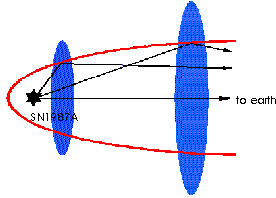Light Echoes
In 1987, a supernova appeared in the Large Magellanic Cloud, the so called supernova SN1987A. One year later, two concentric rings, light echoes, have been observed around the supernova. Such light echoes are formed, when the light of the supernova is reflected at interstellar clouds. Since the distances involved are so great, several years can pass between when an observer on earth sees the pulse of light directly emitted by the supernova and the light reflected by the interstellar material.
For reasons unknown, another star V838 Mon's outer surface suddenly greatly expanded with the result that it became the brightest star in the entire Milky Way Galaxy (January 2002). Then, just as suddenly, it faded. A stellar flash like this has never been seen before -- supernovas and novas expel matter out into space. Although the V838 Mon flash appears to expel material into space, what is seen in this movie is actually an outwardly moving light echo of the bright flash. The actual time-span of the movie is 8 months during 2002. In a light echo, light from the flash is reflected by successively more distant rings in the complex array of ambient interstellar dust that already surrounded the star. V838 Mon lies about 20,000 light years away toward the constellation of Monoceros, while the largest light echo above spans about six light years in diameter.

